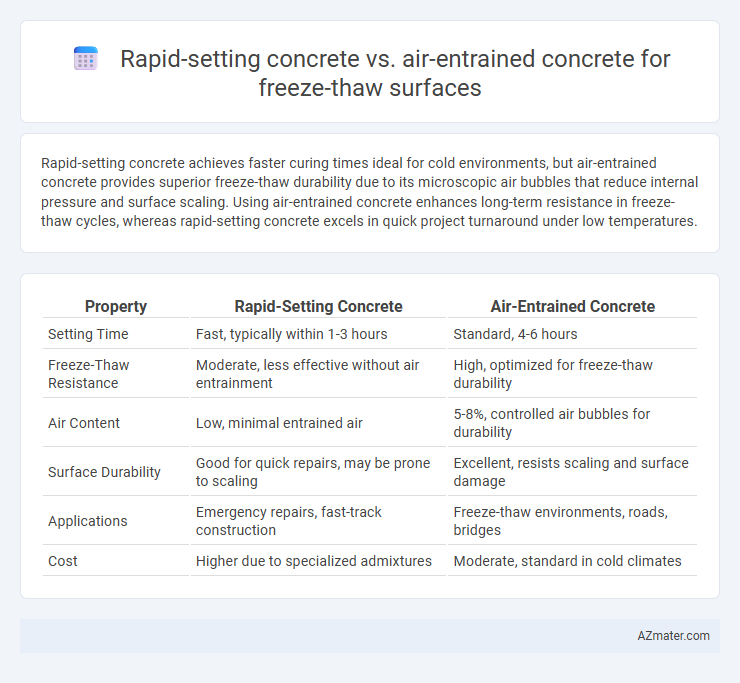Rapid-setting concrete achieves faster curing times ideal for cold environments, but air-entrained concrete provides superior freeze-thaw durability due to its microscopic air bubbles that reduce internal pressure and surface scaling. Using air-entrained concrete enhances long-term resistance in freeze-thaw cycles, whereas rapid-setting concrete excels in quick project turnaround under low temperatures.
Table of Comparison
| Property | Rapid-Setting Concrete | Air-Entrained Concrete |
|---|---|---|
| Setting Time | Fast, typically within 1-3 hours | Standard, 4-6 hours |
| Freeze-Thaw Resistance | Moderate, less effective without air entrainment | High, optimized for freeze-thaw durability |
| Air Content | Low, minimal entrained air | 5-8%, controlled air bubbles for durability |
| Surface Durability | Good for quick repairs, may be prone to scaling | Excellent, resists scaling and surface damage |
| Applications | Emergency repairs, fast-track construction | Freeze-thaw environments, roads, bridges |
| Cost | Higher due to specialized admixtures | Moderate, standard in cold climates |
Introduction to Freeze-Thaw Durability in Concrete
Freeze-thaw durability in concrete is critical for structures exposed to cyclic freezing and thawing, where water within the concrete pores freezes, expands, and causes internal stress leading to surface scaling and cracking. Rapid-setting concrete offers quick strength gain but may lack sufficient air entrainment, which is essential for forming microscopic air bubbles that accommodate ice expansion. Air-entrained concrete improves freeze-thaw resistance by providing controlled air voids that relieve pressure, significantly enhancing the surface durability of concrete in cold climates.
Understanding Rapid-Setting Concrete
Rapid-setting concrete offers accelerated curing times ideal for freeze-thaw surface applications where quick strength development is crucial to resist early frost damage. Its composition typically includes high early-strength cement and chemical accelerators that reduce setting time to as little as 30 minutes, minimizing vulnerability to freezing during initial hydration. Compared to air-entrained concrete, rapid-setting concrete prioritizes speed and early durability but may require supplementary measures to enhance freeze-thaw resistance in prolonged exposure conditions.
Basics of Air-Entrained Concrete
Air-entrained concrete contains microscopic air bubbles that improve durability by providing space for water to expand during freeze-thaw cycles, reducing internal stress and surface scaling. Rapid-setting concrete gains strength quickly for fast repairs but lacks the long-term freeze-thaw resistance provided by air entrainment. Thus, air-entrained concrete is preferred for surfaces exposed to frequent freezing and thawing due to its enhanced durability and resistance to freeze-thaw damage.
Mechanisms of Freeze-Thaw Resistance
Rapid-setting concrete enhances freeze-thaw resistance by quickly achieving early strength, minimizing water ingress and reducing saturation levels that cause internal damage during freezing cycles. Air-entrained concrete improves durability by incorporating microscopic air bubbles that act as pressure relief zones, allowing expanding ice to safely occupy these voids and prevent cracking. Both mechanisms address freeze-thaw damage but differ in strategy: rapid-setting limits water exposure time, while air-entrainment manages internal stress from freeze expansion.
Performance Comparison: Rapid-Setting vs Air-Entrained Concrete
Rapid-setting concrete offers faster strength gain, enabling quicker construction cycles, but it generally has lower freeze-thaw durability compared to air-entrained concrete. Air-entrained concrete contains microscopic air bubbles that enhance resistance to freeze-thaw cycles by absorbing expansion pressures, significantly reducing surface scaling and cracking. Performance evaluations show air-entrained concrete achieves superior long-term durability in freeze-thaw environments, whereas rapid-setting concrete may require supplementary treatments to match this resistance.
Typical Applications and Use Cases
Rapid-setting concrete is ideal for emergency repairs, road patching, and cold-weather construction due to its fast curing time, ensuring minimal downtime in freeze-thaw environments. Air-entrained concrete is commonly used in sidewalks, bridges, and pavements exposed to cyclic freezing and thawing, where enhanced durability and resistance to scaling are critical. Both types are essential in maintaining structural integrity under freeze-thaw conditions, with rapid-setting concrete prioritizing quick strength gain and air-entrained concrete emphasizing long-term freeze-thaw resistance.
Strength and Longevity under Freeze-Thaw Cycles
Rapid-setting concrete achieves early strength gain crucial for quick repairs but may exhibit lower long-term durability under repeated freeze-thaw cycles compared to air-entrained concrete. Air-entrained concrete contains microscopic air bubbles that relieve internal pressure from ice formation, significantly enhancing resistance to freeze-thaw damage and extending surface longevity. Studies demonstrate air-entrained concrete maintains higher residual strength and reduces scaling and cracking, ensuring superior performance in freeze-thaw environments.
Workability and Placement Considerations
Rapid-setting concrete offers faster setting times, allowing quicker finishing and reduced exposure to freeze-thaw cycles, but it demands precise timing during placement to avoid cold joints. Air-entrained concrete improves freeze-thaw durability by incorporating microscopic air bubbles, enhancing workability and resistance to freeze-thaw damage during placement in cold climates. Selecting between these concretes requires balancing rapid strength gain with improved freeze-thaw resilience, considering site conditions and placement schedules.
Cost Implications and Material Availability
Rapid-setting concrete offers cost savings through faster project completion and reduced labor time, while its specialized admixtures may limit material availability in some regions. Air-entrained concrete, designed to endure freeze-thaw cycles by incorporating microscopic air bubbles, generally incurs higher upfront material costs due to air-entrainment agents but benefits long-term durability and reduces repair expenses. Material availability for air-entrained concrete is typically more widespread, making it a preferred choice for freeze-thaw environments where consistent supply and proven performance are critical.
Best Practices for Selecting Concrete for Freeze-Thaw Environments
Rapid-setting concrete offers the advantage of quickly achieving early strength, minimizing exposure time to freeze-thaw cycles during initial curing, but it often lacks inherent freeze-thaw durability without additives. Air-entrained concrete enhances resistance to freeze-thaw damage by incorporating microscopic air bubbles that relieve internal pressure caused by freezing water, making it the preferred choice for long-term durability in freeze-thaw environments. Best practices emphasize selecting air-entrained concrete with proper air content (typically 4-7%) and ensuring adequate curing protocols to optimize freeze-thaw resistance in exposed surface applications.

Infographic: Rapid-setting concrete vs Air-entrained concrete for Freeze-thaw surface
 azmater.com
azmater.com